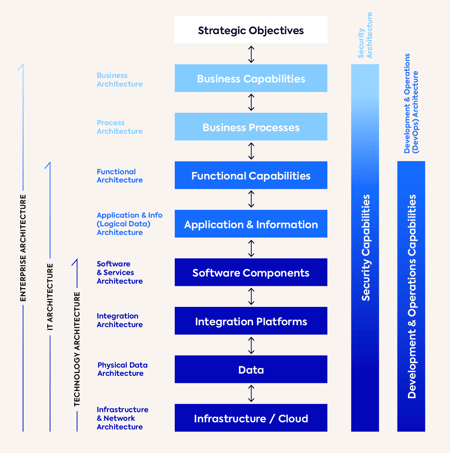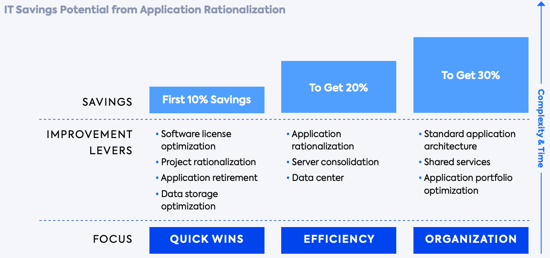Introduction
The only thing digitalization can’t magically align is our individual preferences of how to work. We complete jobs in the ways we want—sometimes logically, sometimes irresponsibly—and by using whatever tools and resources are before us. All of this despite working towards the same goal as everyone else in a company.
Modern and traditional enterprises alike employ IT architects to correct broken processes and augment new strategies by binding them to carefully chosen innovations.
That's where Enterprise Architecture Hub comes in. This Hub is a definitive guide including a curated collection of articles, whitepapers, videos, and other resources that provide a wealth of information.
Whether you're just getting started with EA or you're a seasoned pro, you'll find valuable insights and practical advice that can ensure a fluid EA initiative.
What is enterprise architecture?
Enterprise architecture is a strategic framework that aligns an organization's business strategy, processes, information, and technology to achieve its goals. It provides a holistic view of the organization, enabling effective decision-making, optimization of resources, and adaptation to changes in the business environment.
It is a combination of multiple underlying disciplines, such as:
 Full spectrum of all architectures (Source: itarch.info)
Full spectrum of all architectures (Source: itarch.info)
A specialty devoted equally to the worlds of IT and Business, it introduces practical standards across departmental units and teams in order to streamline efforts with an intelligent sharing of resources.
EA enables IT to become an innovation driver and support business needs for any short-term or long-term change projects.
Purpose of EA
Enterprise architecture aims to establish a framework that outlines an organization’s structure and operations, often through the creation of a business capability map or blueprint. This framework should provide a comprehensive view of the organization, including its IT assets and business processes.
In addition, enterprise architecture also seeks to foster team alignment and standardization by harmonizing environments across teams and organizations. The guidance provided is typically based on an organization’s unique business requirements.
📚 Related: Value of Enterprise Architecture
What is enterprise architecture in simple terms?
If you want to explain enterprise architecture to a non-IT friend, try this: "Enterprise architecture is like a blueprint for a big organization. It shows how all the different parts fit together, like people, tasks, tools, and information. It helps the organization run smoothly and achieve its goals. It’s like a map that guides everyone in the organization, so they know what to do and how it all connects for success."
History of EA
The history of enterprise architecture can be traced back to the 1960s and 1970s when organizations began to realize the need for a systematic approach to managing their growing information technology (IT) infrastructure.
The term "enterprise architecture" was first coined in the 1980s by John Zachman. Throughout the 1990s, various frameworks and methodologies emerged to guide the development and implementation of enterprise architecture.
The adoption of enterprise architecture gained momentum in the 2000s as organizations recognized its value in aligning business strategies with IT investments.
Today, enterprise architecture continues to evolve, adapting to new technologies, business challenges, and the ever-changing landscape of organizations seeking optimal efficiency and agility.
What are the use cases for enterprise architecture?
Enterprise architecture teams previously produced exhaustive 5-year plans consisting of excessive amounts of analysis, slow timelines, and rigid conceptual models.
With the agility and DevOps movement on today’s IT management best practices, these old enterprise architecture mentalities have been forced into obsolescence.

The 7 key use cases of Enterprise Architecture
As the enterprise architecture practice has evolved, its supporting tools have also evolved.
Specialized enterprise architecture-focused tools are scalable, they support complex modeling, company-wide collaboration, useful integrations, and ease of use while enhancing data integrity and quality.
READ ON BELOW



/EN/Poster/EN-Faster-Time-to-Value-Poster-Resource-Page-Thumbnail2024.png?width=260&height=171&name=EN-Faster-Time-to-Value-Poster-Resource-Page-Thumbnail2024.png)
/EN/Poster/EN-M%26A-Roadmap_Poster_Resource_Page_Thumbnail.png?A-Roadmap_Poster_Resource_Page_Thumbnail.png&width=260&height=171&name=EN-M%26A-Roadmap_Poster_Resource_Page_Thumbnail.png?A-Roadmap_Poster_Resource_Page_Thumbnail.png)
/Enterprise-Architecture-roadmap-thumbnail.png?width=260&height=171&name=Enterprise-Architecture-roadmap-thumbnail.png)
/What-to-Look-for-in-a-Modern-EA-Tool_Poster_Resource_Page_Thumbnail.png?width=260&height=171&name=What-to-Look-for-in-a-Modern-EA-Tool_Poster_Resource_Page_Thumbnail.png)


/EN-WP-EA-Tomorrow-Resource_Page_Thumbnail.png?width=260&height=171&name=EN-WP-EA-Tomorrow-Resource_Page_Thumbnail.png)
/EA-Manufacturing-WhitePaper_Resource_Page_Thumbnail.png?width=260&height=171&name=EA-Manufacturing-WhitePaper_Resource_Page_Thumbnail.png)
/EN-WP-Managing_IT-Finance_Industry-Resource_Page_Thumbnail.png?width=260&height=171&name=EN-WP-Managing_IT-Finance_Industry-Resource_Page_Thumbnail.png)




